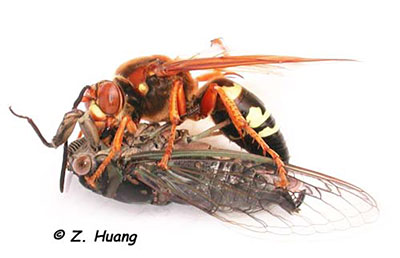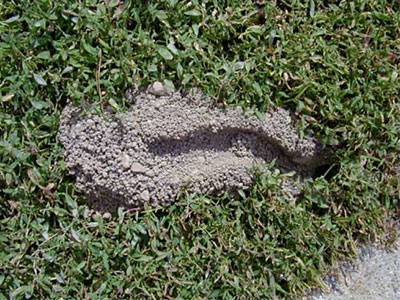Fact Sheet FS040
Few insects can compare with the alarm caused by Cicada Killer Wasps—Sphecius speciosus. These large solitary wasps are also known as Giant Cicada Killers or Sand Hornets. This last common name is a misnomer because they are not true hornets. Despite their very large size, dangerous appearance and "dive-bombing" habit, adults rarely contact people or sting. In fact, the "dive-bombing" male does not even have a stinger and is merely faking a fierce attack. The ovipositor of the female is a tubular egg-laying structure that can function as a very weak stinger. Her mild sting is similar in feel to a slight pin scratch and is not considered painful. Nonetheless, without accurate identification and knowledge, this menacing "bluff" often succeeds in causing fear, anxiety and occasional panic.

Figure 1. Cicada killer wasp attacking its prey.
Description
Identification of this insect is fairly easy just judging on size alone. The adults range in size from 1½ to 1¾ inches in length for females and about 1 to 1¼ inches for males. Both sexes are strikingly colored black, red and yellow which is similar to the warning coloration of common social wasps like yellow jackets which do possess painful stingers. Cicada Killer Wasps have a thick-waisted black body that is striped with yellow across the middle section (thorax) and the first three segments of the rear section (abdomen). Most of the head and parts of the thorax are a dull red (see Fig. 1). All six legs are brightly colored an orangish-red. All four yellowish wings are held straight out when at rest, which is in contrast to most other wasps which fold their wings along their body.
Pest Problem
Homeowners, golfers and picnickers often becoe frightened when in close proximity to Giant Cicada Killers. These wasps can become an unwelcome nuisance as males constantly patrol their underground nesting sites. Male wasps may aggressively fly right up to people in defense of their nest even though they cannot sting. Females are less commonly observed but when captured or mishandled can inflict a mild sting. Her stinger is primarily used to paralyze prey and rarely used in defense except when trapped in clothing or disturbed by lawn equipment. If accidentally stung, there is no cause for alarm except for individuals who are especially sensitive to bee or wasp stings.
Female adults often dig their tunnels in a backyard sandbox, a sand trap on the golf course or in a nice sandy picnic area outdoors. Lawns, gardens, flower beds and athletic fields are other preferred nesting sites. They excavate noticeable amounts of soil around their tunnel entrances and create unsightly mounds. Large soil particles are removed with mouth parts and then shoveled through their legs in a dog-like manner.
Aggregations of individual tunnels can easily exceed 100 in number and last for many years. For these cosmetic and psychological reasons, the wasp could be considered a turfgrass pest, although this insect is essentially harmless.
Biology
Cicada Killer Wasps feed on tree sap and flower nectar as individual adults. Females fly around trees, shrubs, meadows and open areas in search of their only prey species—Cicada species (see fact sheet FS220). The Cicada is used as food to rear the next generation of wasps. The female wasp strikes and stuns the Cicada which reacts with a loud shrieking buzz. Both of these very large insects tumble to the ground where the stinger is then utilized to paralyze the Cicada. This relatively huge prey is laboriously dragged up a tree or tall plant. The Cicada is often held upside down and straddled, after which the wasp takes off and glides home to the nest (Fig. 2).

Figure 2. Nest entrance opening.
The female drags the Cicada through the entrance opening, down the tunnel and into the nesting chamber. She oviposits an egg on the legs of the prey and seals off the cell. Wasp larvae hatch within a few days and penetrate the exoskeleton of the immobilized food source. Larvae feed on the internal tissues and overwinter as mature larvae within a tough, brown-colored cocoon. A monthlong pupation in June leads to adult emergence in July, completing the life cycle. Emergence overlaps with the main availability of the food supply for their nests. This next generation of adults will again dig tunnels, capture Cicadas and live two to three months from July to September.
Underground Nesting Structure
Females dig 1-1½ inch diameter tunnels about a foot deep and two feet long at an angle. At the bottom of the burrow a chamber is constructed with three or four earthen cells. Each cell is stocked with one or two prey for each larva. Additional chambers may be made off the main tunnel branch with additional cells. This nesting structure may house a dozen or more cells.
Control
Control measures are seldom required because Cicada Killer Wasps rarely sting people and only fly as adults for less than two months. If wasp numbers are high or the nests are located in a particularly sensitive area, several control methods have proven successful.
With low populations, an aggregation can be quickly eliminated with the use of a butterfly net or an accurate forearm smash with a tennis racket. Well-aimed aerosol insecticide sprays can repel and reduce patrolling male wasps. Eye, head and body protection is advisable in pursuing this direct capture and control approach. When several tunnels are situated together, a large clear plastic tarp will overheat the ground and deny access.
When resorting to insecticides against the nesting sites, several compounds are available for the homeowner but dust formulations are the most effective. Applications should be made around and into the entrance hole just before sunset or before sunrise to work best as the female will unknowingly carry the toxicant to the brood chamber. Spray timing needs to be early in the lifecycle, generally in July, while the adult is still provisioning the nest after which larvae are sealed off from outside contact. The burrow entrance is the target and should remain open and not be filled in or disturbed. Active insecticidal ingredients include carbaryl (Sevin), bendiocarb (Ficam) and pyrethroids. Always read the label carefully and follow directions. See fact sheet FS212, "Wasps and Their Control", for more information. Call your County Agricultural Agent if you have questions
Mention or display of a trademark, proprietary product, or firm in text or figures does not constitute an endorsement by Rutgers Cooperative Extension and does not imply approval to the exclusion of other suitable products or firms.
Photo Credits: Zachary Huang, Michigan State University, http://cyberbee.msu.edu
May 2004
Copyright © 2025 Rutgers, The State University of New Jersey. All rights reserved.
For more information: njaes.rutgers.edu.
Cooperating Agencies: Rutgers, The State University of New Jersey, U.S. Department of Agriculture, and Boards of County Commissioners. Rutgers Cooperative Extension, a unit of the Rutgers New Jersey Agricultural Experiment Station, is an equal opportunity program provider and employer.

